Features of blue violets and their varieties
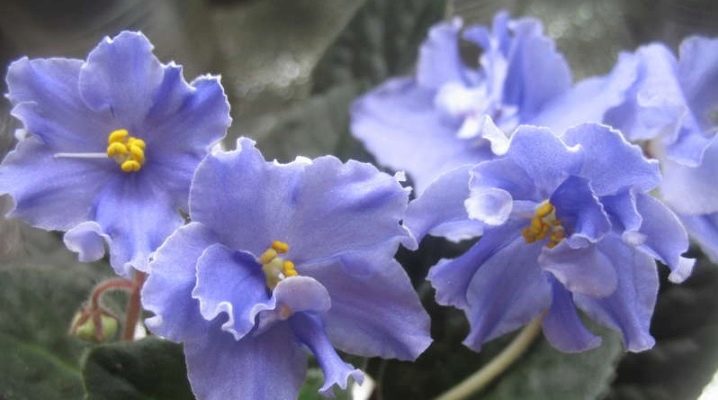
Saintpaulias have long been widely used as indoor flowers. They are presented in a wide variety of species. Even among the blues, there are several varieties to choose from. In the common people, it is customary to call them violets, therefore, in the future, this definition will be used in the article, although it has nothing to do with this type of Saintpaulia.
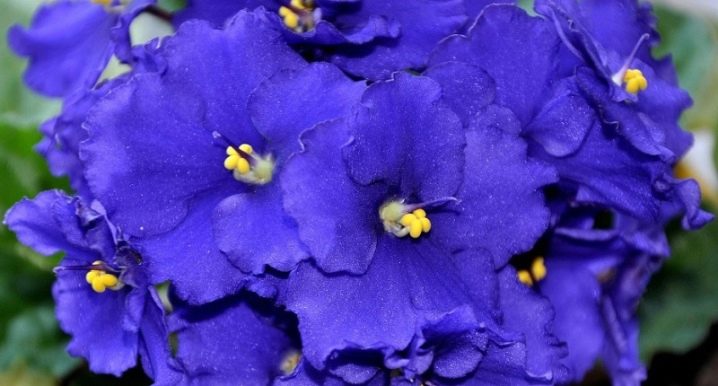
Peculiarities
The first thing that distinguishes the blue violet from all the others is the color. The world was conquered by indigo, sapphire beauties. From the description in old books, we can conclude that blue was especially appreciated in many nations, since it is symbolized with modesty and purity of thoughts. Blue flowers have many distinctive features, different varieties have different foliage in size and color intensity. Their buds can be both numerous and small, and large, but rare. All varieties do not have a pronounced aroma, but the flower is valued not for its smell, but for the beauty of its cap during active flowering.
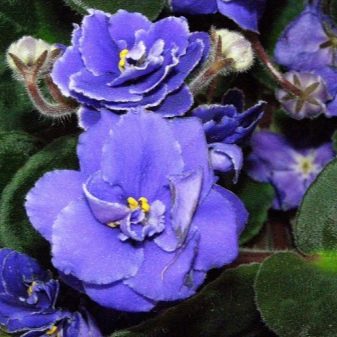
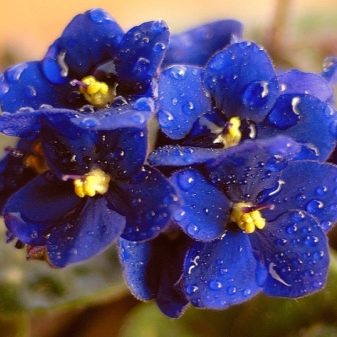
Popular varieties
The most sought after varieties of blue violets are worth considering.
- "Blue blood". The presented variety is distinguished by a very spreading bush. The flowers form into large stars, semi-double with a bright pale blue color. There is a blue spot in the center with a white terry edging. The rosettes are formed of the correct shape, the shade is not too pale, but also dim. The foliage is slightly narrowed upwards and always directed upwards. As for the root system, it is slightly fibrous. Perianths are double, there are 5 petals on the buds.

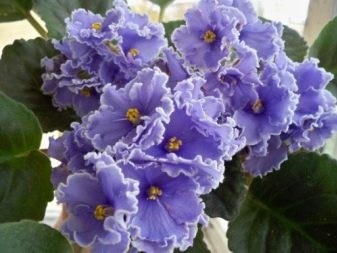
- "Blue-eyed Russia". This type of room violet was introduced to the world by the breeder Korshunova. All types of flowers that she brought out have a prefix, and this one was no exception, so it would be more correct to say "EK-Blue-Eyed Russia". The "Blue Dragon" was used as the mother plant. A delicate color can be distinguished from the distinctive features. The flower develops quickly, completely unpretentious. The rosette can reach 30 centimeters in diameter, the leaves are bright and pointed. Growers are attracted by large flowers, 7 centimeters in diameter, which have a star-shaped shape and can be either double or semi-double. A purple border flaunts around the edges.
The cuttings take root quickly, after six months there will be a flower in the pot with an abundant cap of flowers.
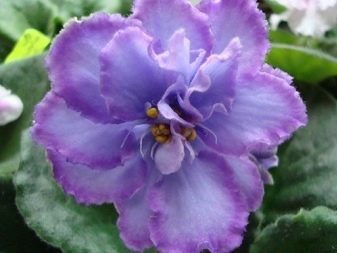
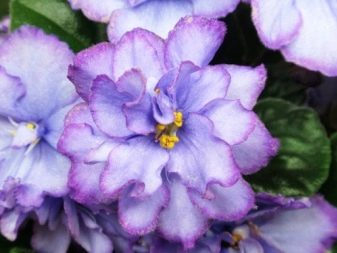
- "Blue Lagoon". This variety stands out among others with rather large buds with terry, which have a rich shade of the color of the sky. From the side in shape, they very much resemble stars with a blue speck in the center. If there is not enough light, then the foliage tends upward. Flowering continues for 2 months. This violet is unpretentious and even a beginner can easily grow it. The rosette is of medium intensity, not too large. For the first time, the variety appeared at the disposal of plant breeders in 2005.
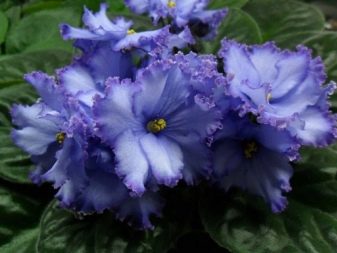

- Blue Flash. This variety of violets is classified as early. It was bred by a domestic scientist named Moreva. His fresh look made it possible to obtain a plant that was able to surpass even foreign counterparts. Of the distinctive features, it is worth noting not only the unique color of the leaves, but also the compactness that the rosettes demonstrate. The petals of the flowers are terry and slightly pointed upwards. On the foliage, you can see small teeth on the edge, on the surface you can see veins of an olive shade.The flowers are very interestingly colored, have a white dusting in the center, slowly turning into blue, made in a wavy shape.
The aroma is impossible to catch, however, like other varieties.
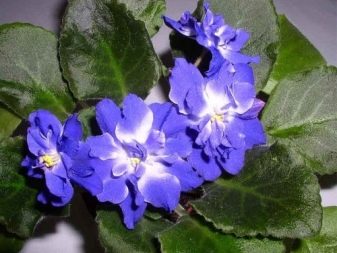
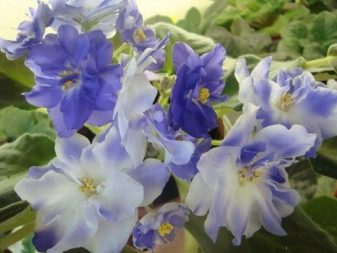
- "N-Avatar". It is difficult for some to classify this variety as violets, since the flowers are more like bells. The foliage is variegated and pointed. In the period when a large number of buds appear, the bush pleases with the abundance of flowering.
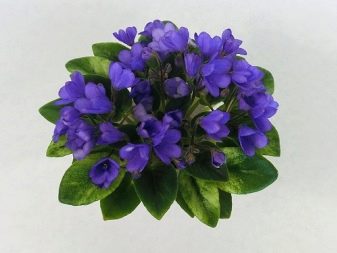
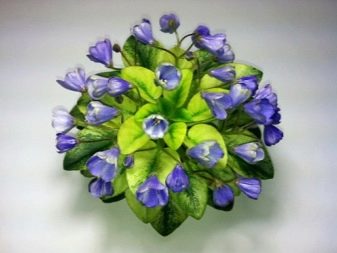
- "Blue Danube". Among the other varieties, this one, bred in the vastness of our country, is considered the most striking. It is difficult not to notice small teeth on the leaves, the green is quite saturated, but the leaves are not glossy, but matte. Blue flowers can be up to 5 centimeters wide. Every year this plant pleases with an abundance of buds, but this will require a sufficient amount of lighting and moisture. If the temperature is maintained correctly, the plant will bloom for a long time.
It propagates easily by leaves.
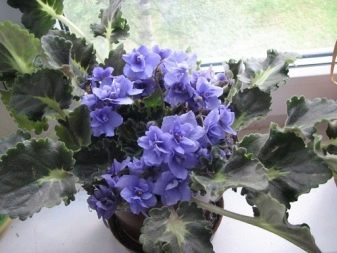
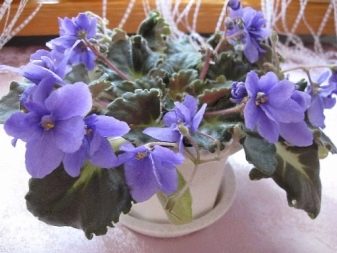
- Blue Dragon. For what plant breeders love the presented variety, it is for large flowers. With proper care, the violet can reach a width of 9 centimeters. Sometimes the flowers have a golden-green border. The variety arose thanks to the American scientist L. Lyon, and received its name in honor of the dragon, which in Eastern mythology is a symbol of wisdom and strength. Up to 50 flowers can form on the bush at the same time. The height of the deciduous rosette in some cases can be 45 centimeters. On the inside, the foliage is red.
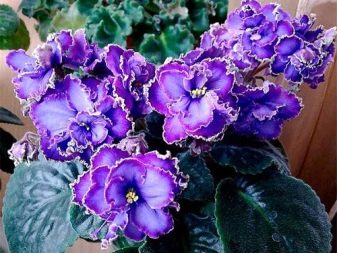
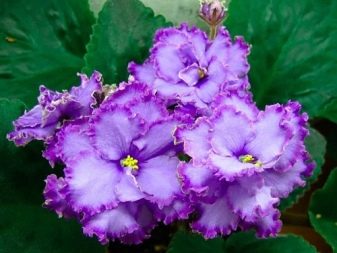
- "Blue Lotus". A greenish edge flaunts on large double stars. The rosette is smooth and variegated. This violet first appeared in the public domain in 2013.
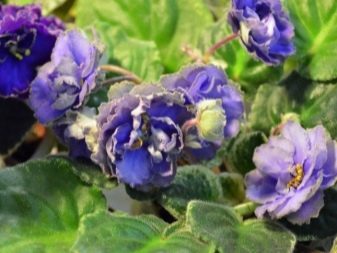
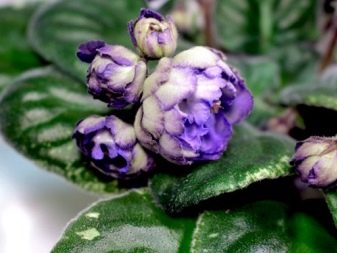
- Honey Blue Ace. It is a miniature flower, the rosette of which can grow up to a maximum of 9 centimeters in diameter. The flowers have a pale blue color, a light green-white border flaunts on the petals. At the time of the appearance of numerous inflorescences, a small cap of a very attractive green palette is formed.
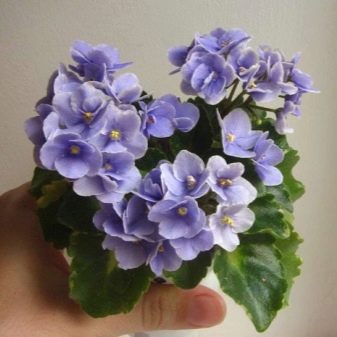
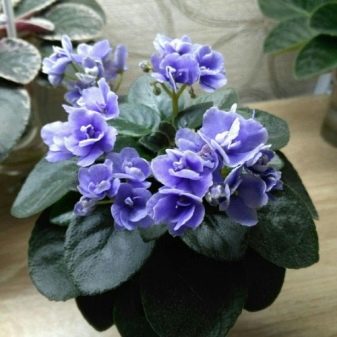
- "Blue bird". This is an ideal variety for an exhibition, which will please with its high growth rate and its not capriciousness to the surrounding conditions. With proper care, the plant will delight the grower with quality flowering. The flowers have a double and small ruffles. The violet has appeared since 2010, along the edge there is a pink wide border, and the edge is distinguished by a white-green combination of colors. The greens are beautiful, dark green in color.
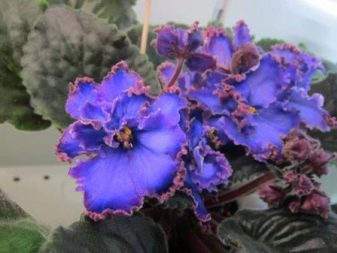

- Valeska Blue. This violet resembles pansy in color, since its petals are dark purple on top, and have a white tip below. There are many flowers in the cap, at the peak a voluminous bush is formed, which pleases for a long time with the brightness of colors.
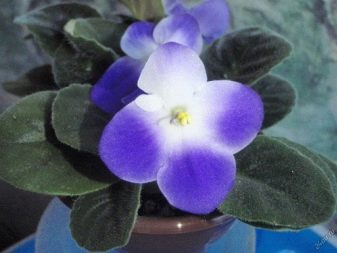
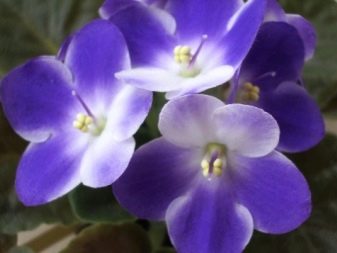
- "PT-Clouds". This violet has large, double buds that delight with a rich blue color. There is a white border along the edge and there is a light green fringe. A flower was born in 2016, but has already managed to fall in love with plant breeders for its unpretentiousness. The rosette is formed from even leaves, they are not too dark in color intensity. Large bright blue inflorescences with terry, there is a white, wavy edge and a thick fringe as a distinctive feature.
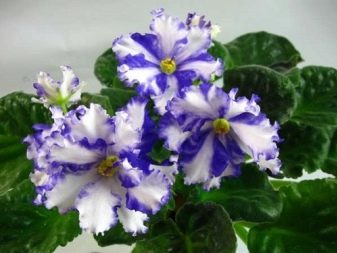
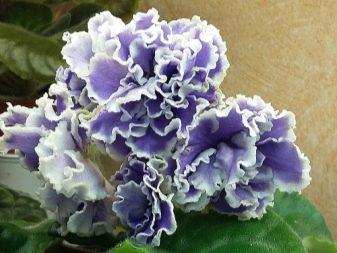
- "RM-Blue Snowdrifts". In the violet in question, during the appearance of peduncles, a thick cap of large buds is formed, in the center you can see a combination of lilac and blue, and the main color of the petals is white. The rosette does not turn out to be crooked, the foliage does not twist, it has an average green color in shade. Flowers have a dense structure. The variety has become available to plant breeders since 2015.
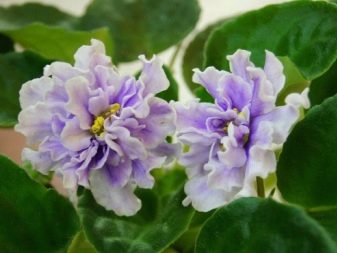
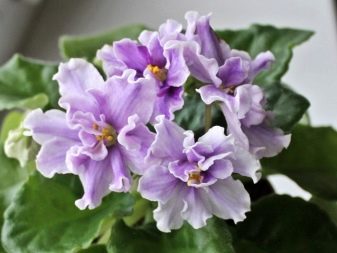
- "LE-Blue Buttercup". This variety was bred by E. Lebetskaya. Large flowers form on the bush, their tips are light blue, the edges have a green edging. The foliage is dark and slightly elongated; it gathers into a flat rosette.
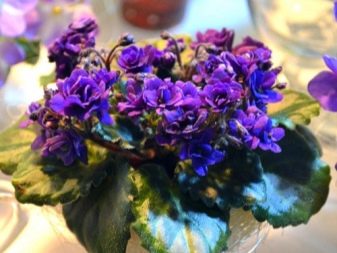
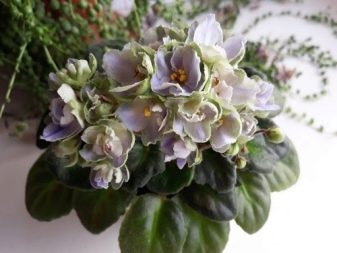
- "LE-Cornflower Blues". Violet is distinguished by simple, star-shaped buds that are painted in cornflower blue with darkening to the edge, where a thin white line runs. The foliage is standard, so is the color.
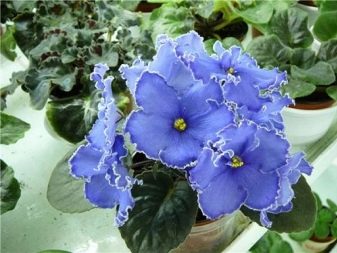
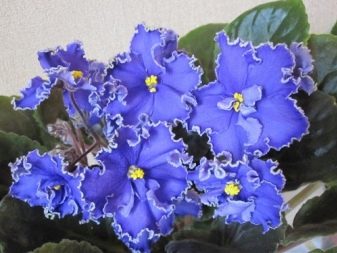
- Honey Blue Angel. During the flowering period, you can find on the bush an abundant amount of semi-double blue buds, which are decorated with a white border. The leaves have a medium green tint, the rosette is never large. In the center of each flower there is an ivory color.
It should be said that the variety is very capricious, so it is not easy to grow, it blooms very rarely.
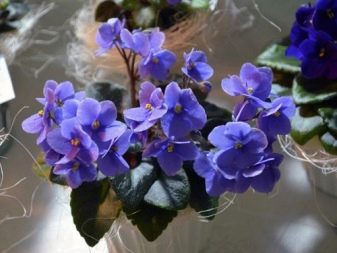
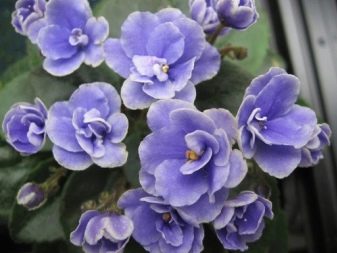
- Ness Crincle Blue. As in most cases, the flowers of this violet are star-shaped. They will delight you with a rich blue color and a white edge. Quilted leaves, dark green, slightly pointed at the tips.
Violet multiplies easily, grows quickly.
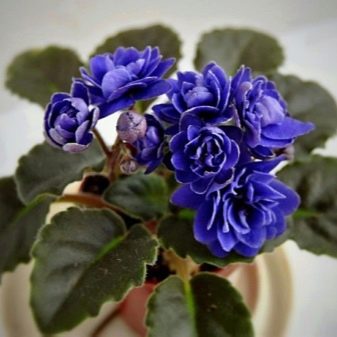
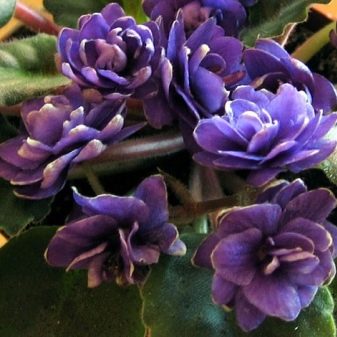
- Ness Blueberry Puff. This variety has a red color on the leaves on the reverse side, the front of a saturated shade, as if covered with gloss. The flowers are dark blue and semi-double.

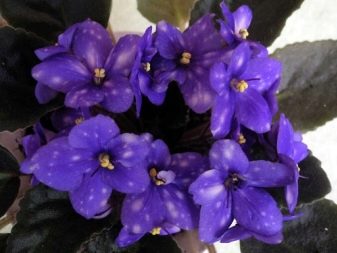
- Alain Organza Blue. The main color prevailing on the flowers of the described violet is white, it is complemented by a violet dusting and green tips. Bred A. Volskaya. The rosette has a standard size, the foliage can sometimes take the shape of a boat.
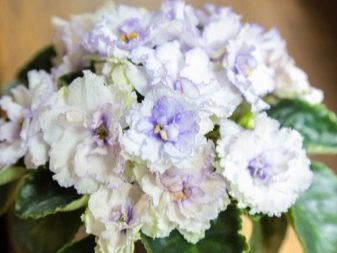
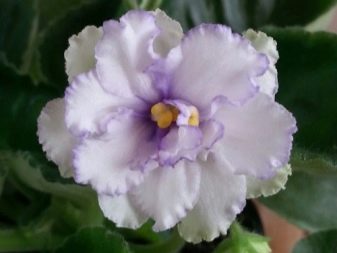
- Blue Alain-Electric. Through selection, it was possible to create a violet with white buds, on which there are purple stains. The buds are semi-double, the leaves are decorated in a palette of light green shades. Growers love violets for their abundant flowering.
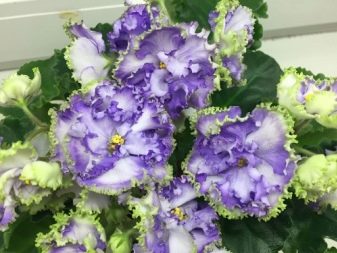
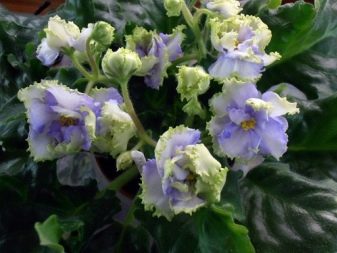
- Blue Tapestry. The foliage of the presented plant has a very rich color from the green palette. The flowers are pink, but not bright, there are blue drops on the petals, as if someone just sprayed them with a brush.
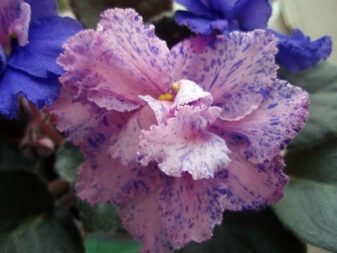
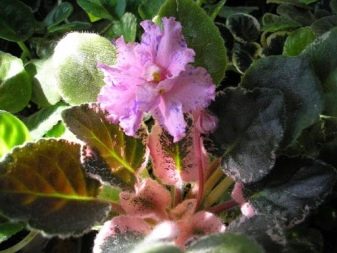
- EK-Blue Diamond. It is a very attractive variety, its buds are quite large, colored in a deep purple hue. The rosette is variegated and medium-sized.
The first flowering is not too abundant.
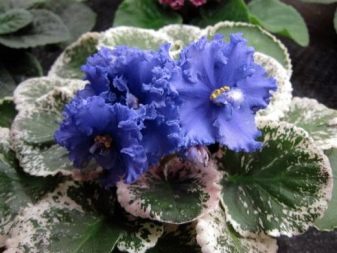
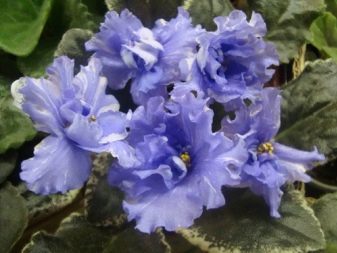
- "EK-Blue Diamond". The variety was bred in 2004, today it pleases with flowers in the form of stars, which are distinguished by a blue-blue tint. Against the background of dark green leaves, they look just gorgeous.
This variety is great for a show.
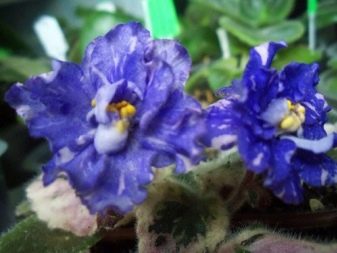
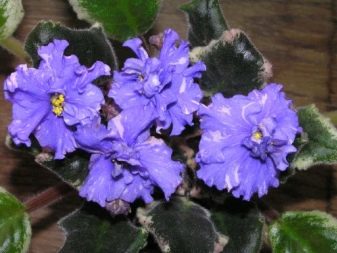
- "LE-Blue Stream". Flowers of impressive size, cupped, on the reverse side of an unusual red color. The color lasts a long time, there are many buds on the bush.

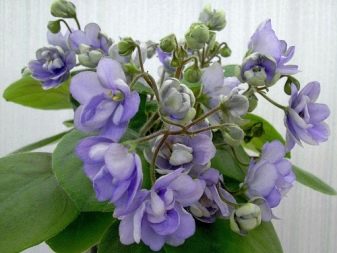
Selection recommendations
When choosing a particular variety, it is worth asking about the predisposition to diseases, the presence of resistance to a decrease in temperature. Each species has its own irreplaceable qualities. Some varieties are especially capricious, so they are not easy to grow for novice growers. Thanks to the art of selection, today there are about 2 thousand hybrids. Among the representatives of the blue color, you can find flowers with star-shaped buds, classic or even limbic in shape.
All violets can be divided into "girls" and "boys", you can recognize them simply by the foliage. If there is a bright spot at the base, then this is a girl. You can find plants with a large outlet or a miniature one, which one to choose depends on the person's preferences. When buying, the first thing a grower needs to pay attention to is the absence of spots on the leaves or gaps between them. All this suggests that the violet is infected. If the bush is very elongated, it means that it was kept in conditions where it did not have enough sun, so it is not clear whether the roots are healthy under the ground.
Each pot must indicate the name and variety, you can compare it with a picture on the Internet, if you do not want to be deceived.
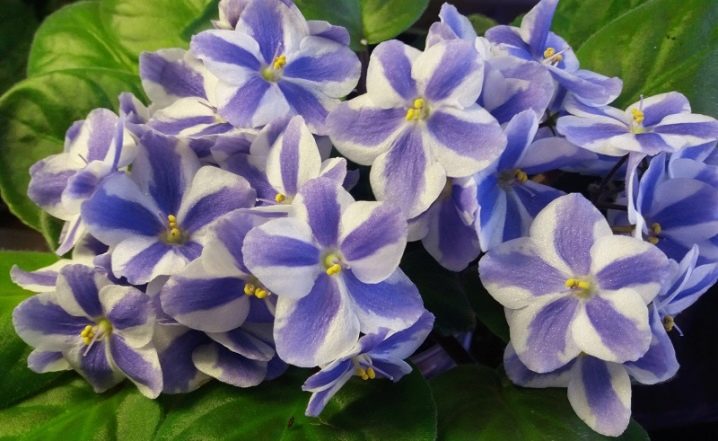
Care Tips
Experienced growers recommend adhering to the following care tips:
- violets require special soil, they will not grow in ordinary garden compost; there is already ready-made soil on the market that is ideal for them, but you can make it yourself, using one part sphagnum moss, perlite and loam;
- choose a container with drainage holes in the bottom; the container can be made of clay or plastic, but in the first case, it is worth monitoring the salting of the soil;
- place a violet on a window that faces north or east in summer and south or west in winter;
- flowers require 10 to 16 hours of bright, indirect sunlight and 8 hours of complete darkness per day; if these requirements are not met, they will bloom;
- when watering, it is necessary to exclude the ingress of moisture on the leaves, otherwise mold or fungus may appear; even a drop can cause ugly stains;
- water for irrigation must be warm;
- before each new watering, it is imperative to check whether the soil is dry enough, since the flower does not like too waterlogged soil;
- the ambient temperature should be between 65 and 70 F; deviation is allowed, but not more than 15 degrees;
- it is required to remove the plants from the window at night to prevent cooling, otherwise it will darken and dry out within 24 hours;
- it is important to maintain high humidity around the violets; you can fill a metal or plastic tray with water and small pebbles and put it next to;
- top dressing is a prerequisite for the normal flowering of violets; experts recommend using a balanced fertilizer designed for flowering indoor plants;
- top dressing is applied once every 2 weeks with watering, the dose should be 4 times less than on the package;
- if you want the plant to constantly delight with flowering, then it is advised to additionally use artificial lighting.
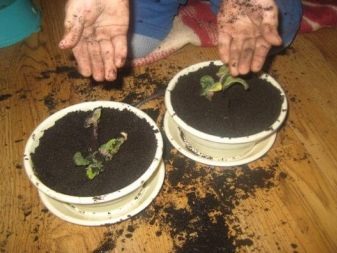

For information on how to grow a violet from a leaf, see the video below.































The comment was sent successfully.